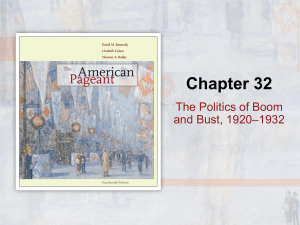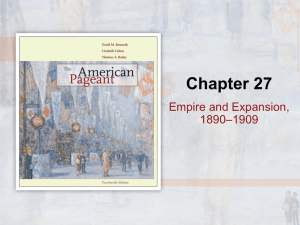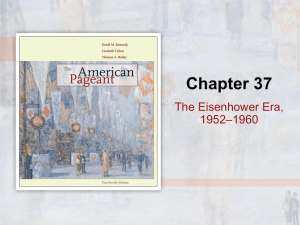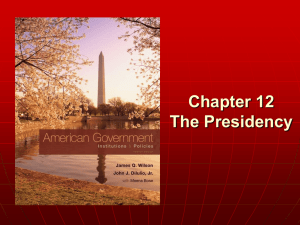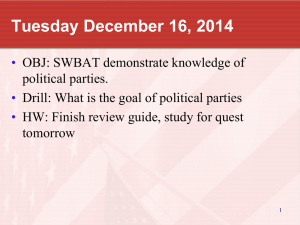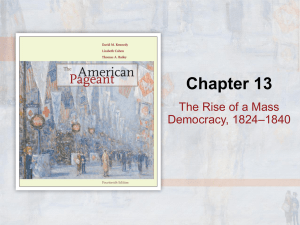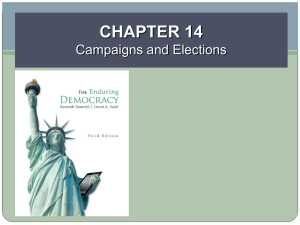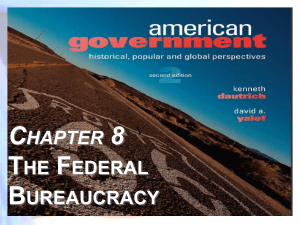Civil Liberties
advertisement
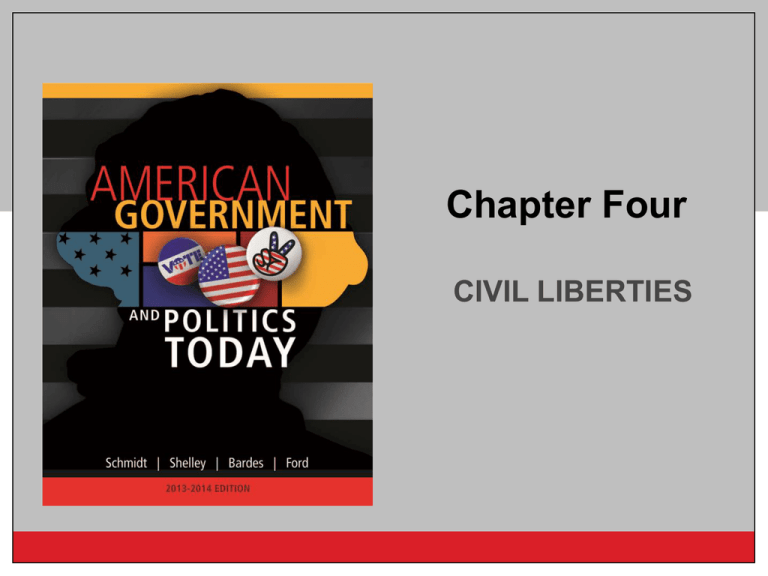
Chapter Four CIVIL LIBERTIES Copyright © 2014 Cengage Learning Our State Standard Today GC.7 Analyze how the Bill of Rights limits the powers of the federal government and state governments. (P) GC.8 Assess the claims, reasoning, and evidence of various authors to analyze the tensions within our constitutional democracy and the importance of maintaining a balance between the following concepts: (H, P) · Liberty and equality · State and national authority in a federal system · Civil disobedience and the rule of law · Freedom of the press and censorship · Relationship of religion and government · Relationship of legislation and morality Copyright © 2014 Cengage Learning Learning Outcomes (Our Objectives Today) 3 1. Explain the origin of the Bill of Rights and discuss how these rights were applied to the states. 2. Explain how the Bill of Rights protects freedom of religion while maintaining a separation between the state and religion. Copyright©©2014 2014 Cengage Cengage Learning Copyright Learning Learning Outcomes (Our Objectives Today) 4 3. Discuss the concept of privacy rights and give examples of how individual privacy is protected under the Constitution. 4. Identify the rights of the accused and discuss the role of the Supreme Court in expanding those rights. Copyright©©2014 2014 Cengage Cengage Learning Copyright Learning Introduction 5 Civil liberties: personal freedoms protected for all individuals Restraints on government actions Americans protected by Bill of Rights First ten amendments to Constitution Broad guidelines, not specific laws Copyright©©2014 2014 Cengage Cengage Learning Copyright Learning The Bill of Rights 6 Colonists feared a tyrannical government Bill of Rights added by Framers to limit national government In practice, shaped by judicial interpretation Must balance personal freedoms with rights of all citizens Early conflict over issue of limiting state government powers Copyright©©2014 2014 Cengage Cengage Learning Copyright Learning The Bill of Rights 7 Extending the Bill of Rights to state governments Barron v. Baltimore Most states had own bill of rights, but still subject to judicial interpretation Incorporation of Fourteenth Amendment Incorporation theory: most Bill of Rights protections apply to state governments Gitlow v. New York Copyright©©2014 2014 Cengage Cengage Learning Copyright Learning Barren vs Baltimore “An 1833 case involving a land dispute in Baltimore led to a holding from the Supreme Court that the Bill of Rights applied only to the federal government and not to the states. Above, a map of the city of Baltimore from the early 19th century.” http://www.pbs.org/wnet/supremecourt/antebellum/landmark_barron.html Gitlow v. New York “Case in which the U.S. Supreme Court ruled on June 8, 1925, that the U.S. Constitution’s First Amendment protection of free speech, which states that the federal “Congress shall make no law…abridging the freedom of speech,” applied also to state governments. The decision was the first in which the Supreme Court held that the Fourteenth Amendment’s due process clause required state and federal governments to be held to the same standards in regulating speech.” http://www.britannica.com/EBchecked/topic/1508178/Gitlow-v-New-York Copyright © 2014 Cengage Learning The Fourteenth Amendment “Ratified in 1868, has generated more lawsuits than any other provision of the U.S. Constitution. Section 1 of the amendment has been the centerpiece of most of this litigation. It makes "All persons born or naturalized in the United States" citizens of the United States and citizens of the state in which they reside. This section also prohibits state governments from denying persons within their jurisdiction the privileges or immunities of U.S. citizenship, and guarantees to every such person due process and equal protection of the laws. The Supreme Court has ruled that any state law that abridges Freedom of Speech, freedom of religion, the right to trial by jury, the Right to Counsel, the right against Self-Incrimination, the right against unreasonable searches and seizures, or the right against cruel and unusual punishments will be invalidated under section 1 of the Fourteenth Amendment. This holding is called the Incorporation Doctrine.” http://legal-dictionary.thefreedictionary.com/fourteenth+amendment What is significant about the year 1868? Copyright © 2014 Cengage Learning Incorporating the Bill of Rights into the Fourteenth Amendment (Page 111) 10 Copyright©©2014 2014 Cengage Cengage Learning Copyright Learning Freedom of Religion 11 The separation of church and state –The Establishment Clause Aid to church-related schools School vouchers School prayer—Engel v. Vitale Prayer outside the classroom The Ten Commandments Teaching evolution Religious speech Copyright©©2014 2014 Cengage Cengage Learning Copyright Learning Engel vs Vitale – 1962 “Almighty God, we acknowledge our dependence upon Thee, and we beg Thy blessings upon us, our parents, our teachers and our Country.” If a public school student were to say this non-denominational prayer quietly to herself, there would be no constitutional conflict. If a group of students were to assemble before school and say this prayer aloud, there would be no constitutional conflict. But what if all public schools in a state began the day with a formal recitation of this prayer? Known as the “Regents Prayer” this invocation was used to open the school day in New York public schools for much of our nation’s history. Students who did not wish to say it could choose to remain silent or stand outside the room, and face no penalty. This practice was challenged in the landmark Supreme Court case Engel v. Vitale. (1962). The First Amendment says “Congress shall make no law respecting an establishment of religion.” This was originally added to the Constitution to keep the federal government from establishing a national religion, and to stop it from interfering with establishments of religion in the states. Today, the amendment is often used to keep religion out of government spaces such as public schools, libraries, and courtrooms. Challenges to religion in schools grew in the Twentieth Century for two reasons: The growth of public schools in the twentieth century, combined with the Supreme Court’s use of the Fourteenth Amendment to apply First Amendment limitations to the states. In Engel v. Vitale, the Court ruled that for public schools to hold official recitation of prayers violated the Establishment Clause. Copyright © 2014 Cengage Learning Questions What was the “Regents’ Prayer”? What was the original reason for adding the Establishment Clause to the Constitution? Why did challenges to religion in schools grow during the twentieth century? How did the Supreme Court rule in Engel v. Vitale (1962), and why? In his dissent, Justice Potter Stewart wrote, “ With all respect, I think the Court has misapplied a great constitutional principle. I cannot see how an ‘official religion’ is established by letting those who want to say a prayer say it. On the contrary, I think that to deny the wish of these school children to join in reciting this prayer is to deny them the opportunity of sharing in the spiritual heritage of our Nation.” http://billofrightsinstitute.org/resources/educator-resources/lessons-plans/landmark-cases-and-theconstitution/engel-v-vitale-1962/ Copyright © 2014 Cengage Learning Freedom of Religion 14 The Free Exercise Clause What defines religious practice? Oregon v. Smith Religious Freedom Restoration Act (1993) National, state and local governments must work to accommodate religious conduct Overturned by City of Boerne v. Flores Copyright©©2014 2014 Cengage Cengage Learning Copyright Learning Oregon vs Smith (1990) Respondents Alfred Smith and Galen Black were fired from their jobs with a private drug rehabilitation organization because they ingested peyote for sacramental purposes at a ceremony of the Native American Church, of which both are members. When respondents applied to petitioner Employment Division for unemployment compensation, they were determined to be ineligible for benefits because they had been discharged for work-related "misconduct". http://www.law.cornell.edu/supct/html/historics/USSC_CR_0494_0872_ZO.html Justice SCALIA delivered the opinion of the Court The Free Exercise Clause of the First Amendment, which has been made applicable to the States by incorporation into [p877] the Fourteenth Amendment, see Cantwell v. Connecticut, 310 U.S. 296, 303 (1940), provides that "Congress shall make no law respecting an establishment of religion, or prohibiting the free exercise thereof. . . . " U.S. Const. Am. I (emphasis added). The free exercise of religion means, first and foremost, the right to believe and profess whatever religious doctrine one desires. Thus, the First Amendment obviously excludes all "governmental regulation of religious beliefs as such." http://www.law.cornell.edu/supct/html/historics/USSC_CR_0494_0872_ZO.html Copyright © 2014 Cengage Learning Boerne v. Flores (1997) Boerne involved the proposed expansion of a Catholic church in Boerne, Texas. The church, built in 1923, was an historic, mission-style structure designated as a landmark by the city, which had nonetheless become too small for its growing parish. The Catholic Archbishop of San Antonio, Patrick Flores, applied for a permit to expand the church, but the City of Boerne denied it, maintaining that the church qualified as a historic structure under the city's historic preservation ordinances, and that local zoning laws forbade the expansion. In Boerne v. Flores (1997), the Supreme Court ruled that Congress exceeded its authority when it passed a law that, among other things, prohibited the states from regulating religious uses of land. http://www.pbs.org/wnet/supremecourt/democracy/landmark_boernes.html Copyright © 2014 Cengage Learning Freedom of Expression 17 Free speech and free press without government interference No prior restraint New York Times v. U.S. (Pentagon Papers) WikiLeaks Protection of symbolic speech Protection of commercial speech Citizens United v. FEC Copyright©©2014 2014 Cengage Cengage Learning Copyright Learning New York Times Co. v. United States [The Pentagon Papers Case] “The United States sought to enjoin the New York Times and the Washington Post newspapers from publishing contents of a confidential study about the Government’s decision making with regards to Vietnam policy.” Ruling “The responsibility must be where the power is. The Executive must have the large duty to determine and preserve the degree of internal security necessary to exercise its power effectively. The Executive is correct with respect to some of the documents here, but disclosure of any of them will not result in irreparable danger to the public. The United States has not met the very heavy burden, which it must meet to warrant an injunction against publication in these cases.” http://www.casebriefs.com/blog/law/constitutional-law/constitutional-law-keyed-to-sullivan/freedom-ofspeech-how-government-restricts-speech-modes-of-abridgment-and-standards-of-review/new-yorktimes-co-v-united-states-the-pentagon-papers-case/2/ Copyright © 2014 Cengage Learning Citizens United vs FEC “Political spending is a form of protected speech under the First Amendment, and the government may not keep corporations or unions from spending money to support or denounce individual candidates in elections. While corporations or unions may not give money directly to campaigns, they may seek to persuade the voting public through other means, including ads, especially where these ads were not broadcast.” http://www.scotusblog.com/case-files/cases/citizens-united-v-federal-election-commission/ What was Citizens United? During the 2008 election, a conservative non-profit organization named "Citizens United" produced Hillary: The Movie, a documentary critical of then-Sen. Hillary Clinton. Because of the political nature of the movie and the fact that Citizens United intended to purchase airtime on a video on-demand service on cable television, the movie was deemed an "electioneering communication" by the Federal Election Commission (FEC) and was therefore subject to the rules governing the production of political ads, including limitations on who may fund them. Citizens United sued in federal court to overturn the decision, lost and appealed to the Supreme Court. Why does this matter? What do you think this means for future elections? Copyright © 2014 Cengage Learning Freedom of the Press 20 Defamation in writing Libel Public figures must meet higher standards New York Times v. Sullivan (1964) Actual malice must take place Made it difficult to prove libel for public figures Copyright©©2014 2014 Cengage Cengage Learning Copyright Learning New York Times vs Sullivan It was 1960 and the Civil Rights Movement was gaining strength. Civil rights leaders ran a full-page ad in the New York Times to raise funds to help civil rights leaders, including Martin Luther King, Jr. Sixty well-known Americans signed it. The ad described what it called “ an unprecedented wave of terror” of police actions against peaceful demonstrators in Montgomery, Alabama. What it described was mostly accurate, but some of the charges in the ad were not true. For example, the ad said that police “ringed” a college campus where protestors were, but this charge was exaggerated. The ad also contained the false statement: “When the entire student body protested to state authorities by refusing to re-register, their dining hall was padlocked in an attempted to starve them into submission.” L.B. Sullivan was one of three people in charge of police in Montgomery. He sued the New York Times for libel (printing something they knew was false and would cause harm). The ad did not mention Sullivan’s name. But Sullivan claimed that the ad implied his responsibility for the actions of the police. He said that the ad damaged his reputation in the community. In the Alabama court, Sullivan won his case and the New York Times was ordered to pay $500,000 in damages. In a unanimous decision, the United States Supreme Court ruled in favor of the New York Times. In order to prove libel, a “public official” must show that the newspaper acted “with ‘actual malice’–that is, with knowledge that it was false or with reckless disregard” for truth. Copyright © 2014 Cengage Learning New York Times vs Sullivan Questions Why did L. B. Sullivan sue the New York Times? How did the Court rule? What was the Court’s reasoning? Do you agree with the Court? Copyright © 2014 Cengage Learning Freedom of the Press 23 Free press versus a fair trial: gag orders Right of a defendant to a fair trial supersedes right of public to “attend” the trial Court permits press to publish factual information Films, radio and TV: No longer limited to print media, though broadcast media do not receive identical protections Copyright©©2014 2014 Cengage Cengage Learning Copyright Learning The Right to Assemble and to Petition the Government 24 First Amendment guarantees Supreme Court: state and local governments cannot bar individuals from assembling Nazi Party Westboro Baptist Church Copyright©©2014 2014 Cengage Cengage Learning Copyright Learning Westboro Baptist Church Copyright © 2014 Cengage Learning Westboro Baptist Church Copyright © 2014 Cengage Learning More Liberties Under Scrutiny: Matters of Privacy 27 No explicit Constitutional right to privacy, but is interpretation by Supreme Court First, Third, Fourth, Fifth, Ninth and Fourteenth Amendments imply “zones of privacy” Griswold v. Connecticut (1965) Privacy rights in an information age Copyright©©2014 2014 Cengage Cengage Learning Copyright Learning Griswold vs Connecticut (1965) In Griswold v. Connecticut (1965), the Supreme Court ruled that a state's ban on the use of contraceptives violated the right to marital privacy. The case concerned a Connecticut law that criminalized the encouragement or use of birth control. The 1879 law provided that "any person who uses any drug, medicinal article or instrument for the purposes of preventing conception shall be fined not less than forty dollars or imprisoned not less than sixty days." The law further provided that "any person who assists, abets, counsels, causes, hires or commands another to commit any offense may be prosecuted and punished as if he were the principle offender." http://www.pbs.org/wnet/supremecourt/rights/landmark_griswold.html Copyright © 2014 Cengage Learning More Liberties Under Scrutiny: Matters of Privacy 29 Privacy rights and abortion Roe v. Wade (1973) Webster v. Reproductive Health Services Planned Parenthood v. Casey The controversy continues Copyright©©2014 2014 Cengage Cengage Learning Copyright Learning Roe v Wade ““We … acknowledge our awareness of the sensitive and emotional nature of the abortion controversy, of the vigorous opposing views, even among physicians, and of the deep and seemingly absolute convictions that the subject inspires.” — Justice Blackmun (1973), majority opinion in Roe v. Wade Jane Roe was an unmarried and pregnant Texas resident in 1970. Texas law made it a felony to abort a fetus unless “on medical advice for the purpose of saving the life of the mother.” Roe filed suit against Wade, the district attorney of Dallas County, contesting the statue on the grounds that it violated the guarantee of personal liberty and the right to privacy implicitly guaranteed in the First, Fourth, Fifth, Ninth, and Fourteenth Amendments. In deciding for Roe, the Supreme Court invalidated any state laws that prohibited first trimester abortions” http://www.streetlaw.org/en/landmark/cases/roe_v_wade Abortion continues to be one of the leading issues in political campaigns and each party's Platform. What is the stance of the Democratic party on the topic of abortion? Why does the Democratic party take that stance? What is the stance of the Republican party on the topic of abortion? Why does the Republican party take that stance? How how does this issue rate in importance to you in future elections you will be voting in? Copyright © 2014 Cengage Learning More Liberties Under Scrutiny: Matters of Privacy 31 Privacy rights and the “right to die” Karen Ann Quinlan case Living wills Physician-assisted suicide Copyright©©2014 2014 Cengage Cengage Learning Copyright Learning Karen Ann Quinlan “On April 14, 1975, after an evening out with friends during which she consumed alcohol and sedatives, the 21-year-old New Jersey resident stopped breathing and lapsed into a coma. After five months, doctors diagnosed Quinlan as being in a persistent vegetative state; her parents, who believed there was no chance of her returning to consciousness and who wanted to end her suffering, requested that Quinlan be disconnected from the machines that were sustaining her. When her doctors refused, they took the case to court — in what became one of the the first "right to die" case in U.S. legal history. Based on the right to privacy, the court ruled that "no compelling interest of the state could compel Karen to endure the unendurable" and allowed her to be taken off life support. Her story made headlines and provided the groundwork for numerous similar cases. But Quinlan's story didn't end there: weaned from the respirator, she survived for nearly 10 more years, dying of pulmonary failure on June 11, 1985 in a New Jersey nursing home.” http://content.time.com/time/specials/packages/article/0,28804,1864940_1864939_1864909,00.html Copyright © 2014 Cengage Learning More Liberties Under Scrutiny: Matters of Privacy 33 Privacy rights versus security issues Fourth Amendment protections Increased in importance after 9/11 attacks Threats to liberty may make rights “too extravagant to endure” USA PATRIOT Act Civil liberties concerns FISA Amendments Act Copyright©©2014 2014 Cengage Cengage Learning Copyright Learning Foreign Intelligence Surveillance Act (FISA) Here's The Law The Obama Administration Is Using As Legal Justification For Broad Surveillance, Brett LoGiurato Jun. 7, 2013 in Business Insider “In an unusual statement late Thursday night, Director of National Intelligence James Clapper justified the Obama administration's broadening surveillance powers under Section 702 of the Foreign Intelligence Surveillance Act. "Section 702 is a provision of FISA that is designed to facilitate the acquisition of foreign intelligence information concerning non-U.S. persons located outside the United States," Clapper said. "It cannot be used to intentionally target any U.S. citizen, any other U.S. person, or anyone located within the United States." FISA, which was first signed into law in 1978, has been repeatedly amended since the Sept. 11, 2001, terrorist attacks. In December, President Barack Obama signed an extension of the FISA Amendment Acts, which were set to expire at the end of last year and include some of the most controversial warrantless interception programs.” http://www.businessinsider.com/fisa-amendments-act-how-prism-nsa-phone-collection-is-it-legal-2013-6 Copyright © 2014 Cengage Learning The Great Balancing Act: The Rights of the Accused versus The Rights of Society 35 Extending the rights of the accused Fourth Amendment No unreasonable or unwarranted search or seizure No arrest except on probable cause Fifth Amendment No coerced confessions No compulsory self-incrimination Copyright©©2014 2014 Cengage Cengage Learning Copyright Learning Basic Rights of Criminal Defendants 36 Copyright © 2014 Cengage Learning The Great Balancing Act: The Rights of the Accused versus The Rights of Society 37 Rights of the accused (continued) Sixth Amendment Legal counsel Informed of charges Speedy and public jury trial Impartial jury by one’s peers Eighth Amendment Reasonable bail No cruel or unusual punishment Copyright©©2014 2014 Cengage Cengage Learning Copyright Learning The Great Balancing Act: The Rights of the Accused versus The Rights of Society 38 Extending rights of the accused Gideon v. Wainwright Miranda v. Arizona Public-safety exceptions Recorded interrogations Rights complicated for Americans outside U.S. borders Copyright©©2014 2014 Cengage Cengage Learning Copyright Learning Gideon vs Wainright (1963) “Clarence Earl Gideon was an unlikely hero. He was a man with an eighth-grade education who ran away from home when he was in middle school. Gideon was charged with breaking and entering with the intent to commit a misdemeanor, which is a felony under Florida law. At trial, Gideon appeared in court without an attorney. In open court, he asked the judge to appoint counsel for him because he could not afford an attorney. The trial judge denied Gideon’s request because Florida law only permitted appointment of counsel for poor defendants charged with capital offenses. At trial, Gideon represented himself – he made an opening statement to the jury, cross-examined the prosecution’s witnesses, presented witnesses in his own defense, declined to testify himself, and made arguments emphasizing his innocence. Despite his efforts, the jury found Gideon guilty and he was sentenced to five years imprisonment. Gideon challenged his conviction and sentence on the ground that the trial judge’s refusal to appoint counsel violated Gideon’s constitutional rights. The US Supreme Court held that the Sixth Amendment’s guarantee of counsel is a fundamental right essential to a fair trial and, as such, applies the states through the Due Process Clause of the Fourteenth Amendment.” http://www.uscourts.gov/educational-resources/get-involved/constitution-activities/sixthamendment/right-counsel/facts-case-summary-gideon.aspx Copyright © 2014 Cengage Learning Miranda v Arizona (1966) “In Miranda v. Arizona, the Supreme Court ruled that detained criminal suspects, prior to police questioning, must be informed of their constitutional right to an attorney and against self-incrimination. The case began with the 1963 arrest of Phoenix resident Ernesto Miranda, who was charged with rape, kidnapping, and robbery. Miranda was not informed of his rights prior to the police interrogation. During the two-hour interrogation, Miranda allegedly confessed to committing the crimes, which the police apparently recorded. Miranda, who had not finished ninth grade and had a history of mental instability, had no counsel present. At trial, the prosecution's case consisted solely of his confession. Miranda was convicted of both rape and kidnapping and sentenced to 20 to 30 years in prison. Miranda appealed to the U.S. Supreme Court, which reviewed the case in 1966. The Supreme Court, in a 5-4 decision written by Chief Justice Earl Warren, ruled that the prosecution could not introduce Miranda's confession as evidence in a criminal trial because the police had failed to first inform Miranda of his right to an attorney and against self-incrimination. The police duty to give these warnings is compelled by the Constitution's Fifth Amendment, which gives a criminal suspect the right to refuse "to be a witness against himself," and Sixth Amendment, which guarantees criminal defendants the right to an attorney.” http://www.pbs.org/wnet/supremecourt/rights/landmark_miranda.html Copyright © 2014 Cengage Learning The Great Balancing Act: The Rights of the Accused versus The Rights of Society 41 Exclusionary Rule Prohibits admission of illegally seized evidence Mapp v. Ohio (1961) Court has limited scope of exclusionary rule in recent decades Copyright©©2014 2014 Cengage Cengage Learning Copyright Learning Mapp vs Ohio (1961) “" . . . our holding that the exclusionary rule is an essential part of both the Fourth and Fourteenth Amendments is not only the logical dictate of prior cases, but it also makes very good sense. There is no war between the Constitution and common sense." —Justice Clark, speaking for the majority Suspicious that Dollree Mapp might be hiding a person suspected in a bombing, the police went to her home in Cleveland, Ohio. They knocked on her door and demanded entrance, but Mapp refused to let them in because they did not have a warrant. After observing her house for several hours, the police forced their way into Mapp's house, holding up a piece of paper when Mapp demanded to see their search warrant. As a result of their search, the police found a trunk containing pornographic materials. They arrested Mapp and charged her with violating an Ohio law against the possession of obscene materials. At the trial the police officers did not show Mapp and her attorney the alleged search warrant or explain why they refused to do so. Nevertheless, the court found Mapp guilty and sentenced her to jail. After losing an appeal to the Ohio Supreme Court, Mapp took her case to the U.S. Supreme Court. The Court determined that evidence obtained through a search that violates the Fourth Amendment is inadmissible in state courts.” http://www.streetlaw.org/en/landmark/cases/mapp_v_ohio Copyright © 2014 Cengage Learning The States and the Death Penalty: Executions 1976-2012 and Death Row Population 43 Copyright©©2014 2014 Cengage Cengage Learning Copyright Learning The Death Penalty 44 Cruel and unusual punishment? Forbidden by Eighth Amendment Supreme Court does NOT restrict all forms of capital punishment Many states adopt bifurcated procedure Death penalty today Allowed by 33 states Carried out mostly by state governments Declining in number Copyright©©2014 2014 Cengage Cengage Learning Copyright Learning Group Work In an orderly manner, go to your group location. Turn to page 140 and research Figure 4-1 in your textbook as a group, discussing each member of your groups' views on the death penalty. What pattern do you see in each state's implementation of the death penalty? Why do these patterns exist? Which state has executed the most inmates since 1976? Which state had the largest number of inmates on Death Row in 2006? Discuss these questions in your group. Now turn to page 139. Look at the photo at the top of the page and read its caption. Discuss these questions: Is the Death Penalty a deterrent against future crime? Is there a consensus of opinion in your group or differing views? What arguments have been made in your group? What is your opinion on the death penalty? Why do you have that opinion? Copyright © 2014 Cengage Learning Our State Standard Today GC.7 Analyze how the Bill of Rights limits the powers of the federal government and state governments. (P) GC.8 Assess the claims, reasoning, and evidence of various authors to analyze the tensions within our constitutional democracy and the importance of maintaining a balance between the following concepts: (H, P) · Liberty and equality · State and national authority in a federal system · Civil disobedience and the rule of law · Freedom of the press and censorship · Relationship of religion and government · Relationship of legislation and morality Copyright © 2014 Cengage Learning Learning Outcomes (Our Objectives Today) 47 1. Explain the origin of the Bill of Rights and discuss how these rights were applied to the states. 2. Explain how the Bill of Rights protects freedom of religion while maintaining a separation between the state and religion. Copyright©©2014 2014 Cengage Cengage Learning Copyright Learning Learning Outcomes (Our Objectives Today) 48 3. Discuss the concept of privacy rights and give examples of how individual privacy is protected under the Constitution. 4. Identify the rights of the accused and discuss the role of the Supreme Court in expanding those rights. Copyright©©2014 2014 Cengage Cengage Learning Copyright Learning Assessment and Closure Explain the origin of the Bill of Rights and discuss how these rights were applied to the states. In your opinion, which of the Ten Bill of Rights is the most important one? Why? Explain how the Bill of Rights protects freedom of religion while maintaining a separation between the state and religion. Do you think Thomas Jefferson's “Virginia Statute of Religious Freedom” is being followed nationally today? Do you think it and the Bill Of Rights is being interpreted correctly or not today when it comes to religion and public places? Do you think the Ten Commandments should be allowed to be put up in our local County Courthouse or not? Discuss the concept of privacy rights and give examples of how individual privacy is protected under the Constitution. Is it as protected today as our forefathers planned it to be? Why do you feel the way you do on this topic? Identify the rights of the accused and discuss the role of the Supreme Court in expanding those rights. What do you hear as someone's rights when watching a television show or movie? Which Supreme Court ruling led to police saying that to suspects? Copyright © 2014 Cengage Learning
